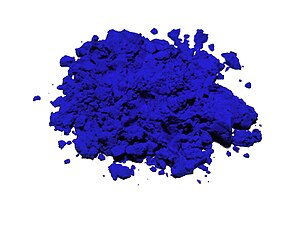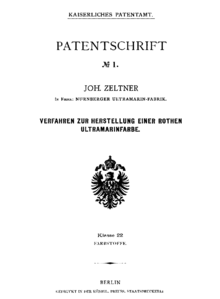Ultramarine
Ultramarine ( Latin ultramarinus 'overseas; over the sea' ) is a blue shade. Ultramarine blue is also a collective name for inorganic pigments of different colors with a similar chemical structure. The pigments are very lightfast . The minerals previously used for pigment production were imported into Europe “across the sea”, which is how the term ultramarine came about.
The shade of ultramarine
Terminology and History
The color of ultramarine is used today to denote the color of the pigment "ultramarine blue dark", which is traded internationally under the name Pigment Blue 29. Blue is often used in advertising to create a positive mood among buyers. In contrast to this, numerous other ultramarine pigments are available that are green or reddish and lighter or darker. All types are processed industrially in everyday products or in artists' colors. Ultramarine green is hardly used today. In a broader sense, the color ultramarine covers the entire range from a green-blue to a deep blue to a dark pink.
The term ultramarine goes back to the history of color procurement and manufacture. The blue stone lapis lazuli and, above all, the pigment "Fra Angelico Blue" made from it, was already very valuable in the Middle Ages because of its durability and the elaborate manufacturing process. Lapis lazuli is also found in China, Persia, and Tibet. The best varieties came to Europe from Afghanistan via Venice as early as the Middle Ages. This is how the name azurro ultramarine came about , which means something like "The blue from beyond the sea". The production of pigments from lapis lazuli is only documented from the early Middle Ages. Fra Angelico Blau is therefore a relatively modern blue pigment. Egyptian blue or Maya blue have a different chemical composition and are much older.
Classification
The Color Index lists the following pigment varieties
- Ultramarine blue as Pigment Blue 29 (77007),
- Ultramarine green as Pigment Green 24 (# 77013; not a commercial product) and Pigment Green 55 (# 77007; currently not a commercial product)
- Ultramarine red as Pigment Red 259
- Ultramarine violet as Pigment Violet 15
RAL color system
In the RAL color system , ultramarine blue is defined as the color RAL 5002. Today it is the color of the technical relief organization and, in general, the signal color for information and protection obligations according to DIN 4844-1: 2012-06
Lapis lazuli from Afghanistan
Natural ultramarine blue, Fra Angelico blue

Natural ultramarine blue or Fra Angelico blue is a pigment extracted from lapis lazuli . The mineral lazurite in the rock lapis lazuli is a complex, sulphurous aluminum silicate , which is blue in color. The rock can only be found at one single site in northern Afghanistan in outstanding quality - i.e. with a high proportion of lazurite. The most is in various cleaning methods from the ground lapis lazuli lightfast blue color pigment won. For this purpose, the lapis lazuli, ground into powder, is mixed with waxes, resins and oils. The mass is then placed in a cotton or linen bag, after which it is kneaded under water. This way, only the finest lazurite particles get through the cloth into the water. Pyrite, lime and other components of the lapis lazuli remain in the clay. The remains in the cloth are called ultramarine ash. A total of up to 49 work steps are necessary for pigment production, which is still the high price today. Albrecht Dürer already balanced the pigment with gold. Due to its preciousness, it could only be used sparingly in painting and was mainly used for pictorial representations of Jesus Christ or the Virgin Mary . It was also used in book illumination .
Synthetic ultramarine blue
A French Committee established in 1824 from a high price for those who might develop a process for the production of artificial ultramarine blue. In 1828 the Frenchman Jean-Baptiste Guimet received the price for the artificial production of ultramarine from quartz , kaolin , soda or sodium sulphate , sulfur and charcoal , which he had succeeded in 1826 two years earlier. Almost simultaneously with Guimet, Christian Gottlob Gmelin in Tübingen developed a corresponding process in 1828.
In 1828 Friedrich August Köttig invented the Meißner Lasursteinblau , a variant of the artificial ultramarine. This manufacturing process was ready for production in 1829.
In 1834 Carl Leverkus founded the first German factory for the manufacture of artificial ultramarine. In 1845 Wilhelm Büchner succeeded in developing a considerably simplified production method, which led to the establishment of his ultramarine factory in Pfungstadt .
In 1836, out of entrepreneurial interests, Johannes Zeltner began promoting the process for the production of ultramarine developed by Thomas Leykauf and Friedrich Wilhelm Heyne (1804–1885). In 1838 he built the first ultramarine factory in Bavaria , the Nuremberg Ultramarine Factory, on what is now Zeltnerstrasse in Nuremberg . On July 2, 1877, Zeltner applied for a patent for his process for the production of a red ultramarine color . This was the very first patent in Germany. The annual world production today is over 20,000 tons.
Manufacturing
The following raw materials are used for the production of synthetic, pure blue ultramarine:
- Iron-free kaolin (Al 2 O 3 · 2SiO 2 · 2H 2 O) or another pure clay mineral ; with the latter, however, the ratio of silica (SiO 2 ) to aluminum oxide (Al 2 O 3 ) should be as close as possible to that of kaolin for a good result ;
- calcined (anhydrous) sodium sulfate (Na 2 SO 4 );
- calcined sodium carbonate ( washing soda ) (Na 2 CO 3 );
- Sulfur (powdered) and
- Activated charcoal powder or charcoal with a very low ash content , or rosin .
In order to remedy the poor resistance to acids, more acid-resistant types were developed in which the pigment particles are coated with silicates or silica glass. However, further processing processes, in particular grinding , reduce the protective effect of this coating. Ultramarine is not very suitable for plastic systems and paints that are processed under acidic conditions, since it decomposes over time in the presence of these weak acids.
Low-silica ultramarine
A low-silica product is obtained by combining a mixture of soft clay, Glauber's salt ( sodium sulfate ), activated charcoal, soda and sulfur. The product is initially white , but the color quickly changes to green ( green ultramarine ) when heated after adding the sulfur. The mixture ignites and after burning out the desired blue pigment is obtained.
Silica-rich ultramarine
A product rich in silica is generally obtained by heating a mixture of pure clay (mineral), very fine white sand, sulfur and activated carbon in a muffle furnace . A blue product is soon obtained which, however, often also has a reddish hue. The different ultramarines - blue, green, red to violet ( ultramarine violet ) - are finely ground and washed out with water.
Manufactured from zeolite
Instead of kaolin, ultramarine can also be produced from synthetic zeolite A , soda and sulfur at lower temperatures from 500 ° C.
Chemical structure and properties
Synthetic and natural ultramarines - regardless of their color - are based on the very similar chemical structure of the colorless sodalite mineral. This mineral belongs to the clathrates , which have a system of very small cavities (cages). In sodalite, the cavities are so small that only a few atoms fit into these cages. The lattice structure is made up of aluminum, silicon and oxygen atoms and contains sodium ions, which "clog" the channels and produce electrical neutrality.
In the case of the ultramarines, the cavities contain simply negatively charged polysulfide radical anions. These “trapped” ions behave differently than elemental sulfur. They absorb the light of a certain energy, this corresponds to a certain wavelength . They form a color center . If white light, such as sunlight, falls on the pigment, the absorbed portion of the light is missing after reflection by the pigment. The person now feels a color . The color of the pigment depends on the structure and the number of “trapped” polysulphide ions. Specifically, there are polysulphide radical ions, the yellow-green , the blue and the red .
A special feature of these ultramarine pigments is their high color stability. The free polysulphide radical anions are inherently not stable to air. In the “sodalite cages”, however, they are protected from chemical attack (especially by oxygen). The “color centers” are retained. The physical process of absorption is based on electron processes, which here have no influence on the inorganic matrix .
The refractive index of ultramarine blue is 1.5.
Chemical formulas
- CI Pigment Blue 29 (77007) with a molar mass of 916 to 1026 g / mol
- Ultramarine blue light: Na 6 Al 6 Si 6 O 24 S 2
- Ultramarine blue medium: Na 7 Al 6 Si 6 O 24 S 3
- Ultramarine blue dark: Na 8 Al 6 Si 6 O 24 S 4
- CI Pigment Violet 15 (77007) with a molar mass of 874 to 918 g / mol
- Ultramarine pink: H 2 Na 4 Al 6 Si 6 O 24 S 2
- Ultramarine pink: H 2 Na 6 Al 6 Si 6 O 24 S 2
More facts
- Wilhelm Büchner succeeded in simplifying the production of artificial ultramarine around 1841. He should do that to his mother with There we have the million! have commented.
- Ultramarine is used in stuff printing .
- When using ultramarine in oil paints , as with earth colors or zinc white, the use of siccatives is necessary to accelerate the drying process.
- Since ultramarine - like cinnabar and auripigment - is a sulfide-containing pigment, when used at the same time as white lead, the color tones will age. In watercolors and various other binders, blackening appears after a long time due to the formation of deep black lead sulfide .
- Ultramarine (1933) is the title of a short story by Malcolm Lowry .
- The flag of Barbados has the tricolor in the shades of ultramarine blue, golden yellow and ultramarine blue.
- The painter and performance artist Yves Klein had his International Klein Blue (IKB), his special “Ultramarine Blue”, patented in 1957 . With the help of a "special" binding agent, he brought the luminosity of the pure pigment onto the canvas.
- The vehicles and uniforms of the technical relief organization are colored ultramarine blue.
literature
- A. Kurella, I. Strauss: Lapis lazuli and natural ultramarine . In: Maltechnik-Restauro. 1983, pp. 34-54.
- S. Muntwyler: Ultramarine. The pigment from across the seas . In: C. Cattaneo, S. Muntwyler, M. Rigert, HP Schneider (eds.): Color pigments, dyes, color stories. 2nd Edition. Alata Verlag, Winterthur 2011, ISBN 978-3-033-02968-2 .
- T. Seilnacht: DVD-ROM chemistry , lexicon of dyes and pigments, Seilnacht Verlag & Atelier, Bern 2017.
Web links
- Herbert Röhrig: Three thousand years of ultramarine. In: paint and varnish. Centralblatt 1933.
- Ultramarine blue. In: Seilnacht's Lexicon of Dyes and Pigments
- The Identification of Blue Elements in Early Sienese Paintings by Color Infrared Photography. In: The Journal of the American Institute for Conservation. Vol. 30. No. 2, 1991, pp. 115-124.
- Ultramarine, natural. In: Colourlex.com
- Ultramarine, artificial. In: Colourlex.com
Individual evidence
- ↑ a b Temple C. Patton: Pigment Handbook . John Wiley Sons, New York / London / Sydney / Toronto 1973, p. 409 ff.
- ↑ Ultramarine: one pigment - many qualities ( Memento of the original dated May 8, 2013 in the Internet Archive ) Info: The archive link was inserted automatically and not yet checked. Please check the original and archive link according to the instructions and then remove this notice.
- ↑ ultramarine (in English)
- ↑ Fra Angelico Blau in Seilnacht's Lexicon of Dyes and Pigments.
- ↑ Entry on ultramarine pigments. In: Römpp Online . Georg Thieme Verlag, accessed on June 12, 2014.
- ↑ Ultramarine blue_medium
- ↑ Pigments ultramarine red
- ↑ Pigments ultramarine violet
- ↑ Fra Angelico Blau in Seilnacht's Lexicon of Dyes and Pigments.
- ^ Ravi Mangla: True Blue: A brief history of ultramarine. In: the Paris Review. June 8, 2015, accessed June 13, 2015 .
- ↑ Fritz Seel , Gisela Schäfer, Hans-Joachim Güttler, Georg Simon: The Secret of Lapis Lazuli . In: Chemistry in Our Time . tape 8 , no. 3 , 1974, p. 65-71 , doi : 10.1002 / ciuz.19740080302 .
- ^ Friedrich Wilhelm Heyne: Treatise on the chemical-technical preparation of ultramarine colors after the invention of Leykauf and Heyne or on the importance of the blue and green ultramarine production for science, art and trade . Campe, Nuremberg 1840. ( Digitized edition of the University and State Library Düsseldorf )
- ^ Press service of the German Patent and Trademark Office: 125 years of the German Patent and Trademark Office. ( Memento of March 7, 2005 in the Internet Archive )
- ↑ Ultramarine blue in Seilnacht's Lexicon of Dyes and Pigments.
- ↑ S. Kowalak include: Application of Zeolites as matrices for pigments . In: Microporous and Mesoporous Materials . tape 61 , 2003, p. 213-222 , doi : 10.1016 / S1387-1811 (03) 00370-6 .
- ↑ http://ruby.chemie.uni-freiburg.de/Vorlesung/silicate_8_8.html Sodalite and Ultramarine on the website of the Albert-Ludwigs-Universität Freiburg
- ↑ Ingo Klöckl: Chemistry of colorants: In painting . Walter de Gruyter GmbH & Co KG, 2015, ISBN 978-3-11-037453-7 ( google.de [accessed on September 28, 2016]).
- ^ Ingrid Pfeiffer, Carla Orthen: Biography. In: Oliver Berggruen, Max Hollein, Ingrid Pfeiffer (Ed.): Yves Klein. Kunsthalle Schirn, Frankfurt am Main, p. 222 f.








